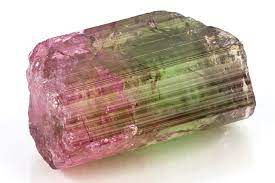
Gemstones have captivated human beings for centuries with their mesmerizing allure and mystical properties. Among these precious gems, tourmaline stands out as a gemstone of exceptional beauty and diverse colors. Revered for its unique characteristics, tourmaline holds a significant place in the world of gemology and jewelry.
Tourmaline derives its name from the Sinhalese word "turmali," which means "mixed colors." This gemstone can be found in various countries, including Brazil, Sri Lanka, Afghanistan, and Nigeria. It is a complex borosilicate mineral that forms in a wide range of geological settings, such as pegmatites, granites, and metamorphic rocks.
The formation of tourmaline is a result of intricate geological processes involving the crystallization of magma and hydrothermal activities. These processes give rise to the gem's remarkable diversity in colors, caused by variations in chemical composition and trace elements present during its formation.
One of the most fascinating aspects of tourmaline is its pleochroism, the ability to exhibit different colors when viewed from different angles. This property, along with its varied color range, makes tourmaline a highly sought-after gemstone for jewelry. From vibrant hues of green, pink, and blue to rare color-changing and bi-colored varieties, tourmaline offers a plethora of options to gem enthusiasts.
In addition to its captivating colors, tourmaline also exhibits exceptional durability. With a hardness of 7 to 7.5 on the Mohs scale, it possesses excellent resistance to scratching, making it suitable for everyday wear. However, due to its natural occurrence in long prismatic crystals, tourmaline may have a tendency to cleave, requiring careful handling during cutting and setting.
Types of Tourmaline
Tourmaline encompasses several distinct varieties, each possessing its unique charm. Some prominent types include:
a. Elbaite: Elbaite is the most renowned and valued variety of tourmaline. It is characterized by its vivid and intense colors, including vibrant greens, blues, pinks, and yellows. Paraíba tourmaline, a type of elbaite, is particularly esteemed for its neon blue and green hues.
b. Schorl: Schorl, also known as black tourmaline, is the most common variety. Its deep black coloration, often opaque, has led to its use in jewelry and as a protective talisman against negative energies.
c. Rubellite: Rubellite is the red or pink variety of tourmaline. It showcases hues ranging from delicate rose to rich, intense red. Its attractive color and excellent transparency make it a highly sought-after gemstone.
d. Watermelon Tourmaline: This unique variety exhibits a captivating color gradient resembling a slice of watermelon, with a green exterior and a pink or red interior. It is highly valued for its rarity and striking appearance.
e. Indicolite: Indicolite refers to the blue variety of tourmaline. Ranging from pale to intense blue shades, it exudes a serene and tranquil aura, captivating gem enthusiasts.
Tourmaline has been revered and used for its spiritual and healing properties across different cultures. In ancient times, it was believed to possess protective qualities, shielding the wearer from negative energies and promoting positive energy flow. Today, tourmaline is often associated with balance, harmony, and emotional well-being.
Many people believe that different colors of tourmaline possess unique metaphysical properties. For instance, pink tourmaline is considered to enhance feelings of love and compassion, while green tourmaline is believed to promote abundance and attract prosperity.
Tourmaline, a crystalline mineral with a diverse range of colors and compositions, holds great geological and economic significance. Nigeria, blessed with abundant mineral resources, is home to significant tourmaline deposits. This article aims to explore the location of tourmaline deposits in Nigeria and shed light on their various uses.
Tourmaline is a complex borosilicate mineral composed of aluminum, iron, magnesium, sodium, lithium, and other elements. It is characterized by its prismatic crystals and remarkable variation in color, including pink, green, blue, red, black, and multi-colored varieties. The name "tourmaline" is derived from the Sinhalese word "turmali," meaning "mixed gemstones."
Tourmaline Deposits in Nigeria
Nasarawa State, located in north-central Nigeria, is renowned for its significant tourmaline deposits. The deposits are primarily found in the Kokona and Nasarawa local government areas. The tourmaline from this region exhibits a variety of colors, including pink, green, and watermelon (pink and green combination). The presence of these deposits has stimulated mining activities, attracting local and international gemstone enthusiasts.
In southwestern Nigeria, Oyo State stands out as another prominent location for tourmaline deposits. The deposits are predominantly found in the Komu, Ibadan, and Oke-Ogun areas. The tourmaline here showcases vibrant green and pink hues, making it highly desirable in the gemstone market. Mining operations in Oyo State have contributed to the socio-economic development of the region.
Kwara State, situated in north-central Nigeria, is also known for its tourmaline deposits. The state's Asa, Ilorin, and Moro local government areas have been identified as significant locations for tourmaline mining. The tourmaline found here varies in color, including green, pink, and bi-colored specimens. These deposits have provided a source of livelihood for many local communities.
Uses of Tourmaline
Gemstone Industry: Tourmaline's captivating colors and transparency make it a highly sought-after gemstone. It is extensively used in the jewelry industry for crafting necklaces, bracelets, earrings, and rings. The vibrant pink and green tourmalines from Nigeria, in particular, are cherished by gemstone connoisseurs worldwide. The gemstone trade has contributed to the growth of Nigeria's export industry and generated foreign exchange earnings.
Industrial Applications: Tourmaline's unique electrical and thermal properties make it valuable for various industrial applications. It is used in the production of high-quality semiconductors, electrical components, and pressure sensors. Additionally, tourmaline's pyroelectric and piezoelectric properties have found applications in the manufacturing of infrared detectors, accelerometers, and pressure-sensitive instruments.
Alternative Medicine and Wellness: Tourmaline is believed to possess certain healing and wellness properties. It is commonly used in alternative medicine therapies, such as crystal healing and energy balancing. Tourmaline-infused products, including massage stones, bracelets, and bedsheets, are used for their purported ability to promote relaxation, improve circulation, and alleviate stress.
Scientific Research: Tourmaline's unique physical and chemical properties make it a subject of interest in scientific research. Its use as a mineral specimen aids in studying crystallography and mineralogy. Researchers also explore tourmaline's role in geochronology, as it can serve as a useful tool for dating geological formations.
In conclusion, Nigeria's rich and diverse tourmaline deposits have put the country on the global gemstone map. The tourmaline mining industry in Nigeria has provided economic opportunities and contributed to the nation's mineral resource development. The gemstones extracted from Nigerian deposits are highly valued in the international market for their vibrant colors and unique characteristics.
Furthermore, tourmaline's industrial applications and its use in alternative medicine and scientific research showcase its versatility. As Nigeria continues to harness its mineral resources, the tourmaline industry is poised for growth and recognition on a global scale.






















